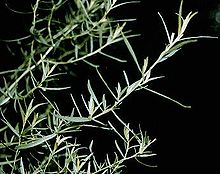 |
|
|
|
|
| Cuisines | Herbal | Spice | Curry | Yeast | Recipe | ||||||
|
Tarragon Tarragon, dragon's-wort, French tarragon, Russian tarragon, silky wormwood, or wild tarragon (Artemisia dracunculus) is a perennial herb in the family Asteraceae related to wormwood. Corresponding to its species name, a common term for the plant is "dragon herb". It is native to a wide area of the Northern Hemisphere from easternmost Europe across central and eastern Asia to India, western North America, and south to northern Mexico. The North American populations may, however, be naturalized from early human introduction. Tarragon grows to 120–150 cm tall, with slender branched stems. The leaves are lanceolate, 2–8 cm long and 2–10 mm broad, glossy green, with an entire margin. The flowers are produced in small capitulae 2–4 mm diameter, each capitulum containing up to 40 yellow or greenish-yellow florets. (French tarragon, however, seldom produces flowers.) CultivationFrench tarragon is the variety generally considered best for the kitchen, but is difficult to grow from seed. It is best cultivated by root division. It is normally purchased as a plant, and some care must be taken to ensure that true French tarragon is purchased. A perennial, it normally goes dormant in winter. It likes a hot, sunny spot, without excessive watering. Russian tarragon (A. dracunculoides L.) can be grown from seed but is much weaker in flavor when compared to the French variety. However, Russian tarragon is a far more hardy and vigorous plant, spreading at the roots and growing over a meter tall. This tarragon actually prefers poor soils and happily tolerates drought and neglect. It is not as strongly aromatic and flavorsome as its French cousin, but it produces many more leaves from early spring onwards that are mild and good in salads and cooked food. The young stems in early spring can be cooked as an asparagus substitute. Horticulturists recommend that Russian tarragon be grown indoors from seed and planted out in the summer. The spreading plants can be divided easily. HealthTarragon has an aromatic property reminiscent of anise, due to the presence of estragole, a known carcinogen and teratogen in mice. The European Union investigation revealed that the danger of estragole is minimal even at 100–1,000 times the typical consumption seen in humans. Culinary useTarragon is one of the four fines herbes of French cooking, and is particularly suitable for chicken, fish and egg dishes. Tarragon is the main flavoring component of Béarnaise sauce. Fresh, lightly bruised sprigs of tarragon are steeped in vinegar to produce tarragon vinegar. Tarragon is used to flavor a popular carbonated soft drink in the countries of Azerbaijan, Armenia, Georgia and, by extension, Russia, Ukraine and Kazakhstan. The drink, named Tarhun (Armenian pronunciation: [tɑɾˈxun] Тархун), is made out of sugary tarragon concentrate and colored bright green. In Slovenia, tarragon is used as a spice for a traditional sweet cake called potica. In Hungary a popular kind of chicken soup is flavored with tarragon. cis-Pellitorin, an isobutyramide eliciting a pungent taste, has been isolated from Tarragon plant. Biochemical effectsTarragon reduces platelet adhesion and blood coagulation and thus may help prevent cardiovascular disease. In one study in rats, tarragon showed significant antihyperglycemic activity in streptozotocin-induced rats compared to the standard drug. The herb has the potential to act as antidiabetic as well as antihyperlipidemic. An ethanolic extract of Artemisia dracunculus alleviated peripheral neuropathy in high fat diet-fed mice (a model of prediabetes and obesity). ChemistryA. dracunculus oil contained predominantly phenylpropanoids such as methyl chavicol (16.2%) and methyl eugenol (35.8%). Gas chromatography/mass spectrometry analysis of the essential oil revealed the presence of trans-anethole (21.1%), α-trans-ocimene (20.6%), limonene (12.4%), α-pinene (5.1%), allo-ocimene (4.8%), methyl eugenol (2.2%), β-pinene (0.8%), α-terpinolene (0.5%), bornyl acetate (0.5%) and bicyclogermacrene (0.5%) as the main components. |











